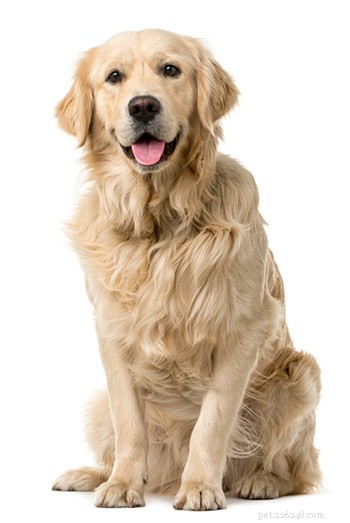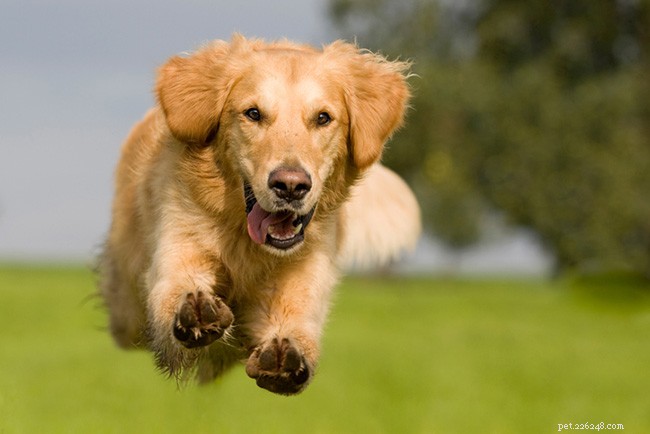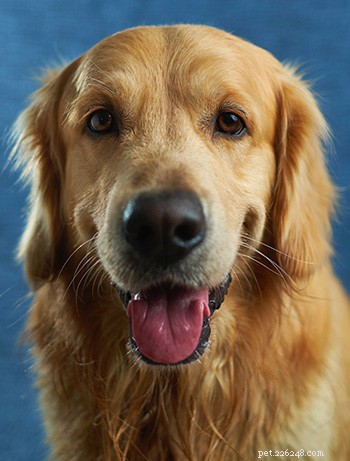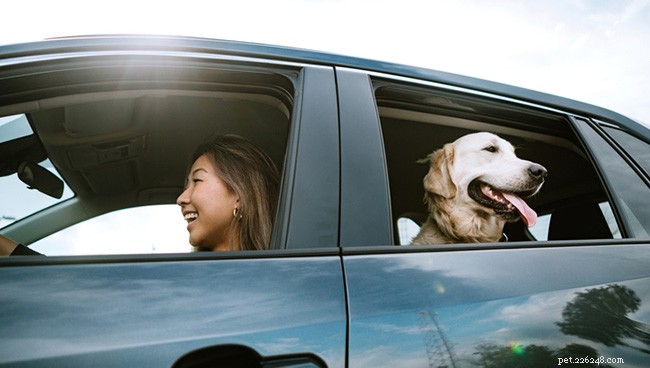Introduction aux Golden Retrievers
Connus pour être des chiens intelligents avec un tempérament amical et une loyauté durable, les Golden Retrievers font partie des races de chiens les plus populaires en Amérique. Ces chiens bien-aimés ont de beaux manteaux dorés et sont d'excellents chiens de famille car ils sont dignes de confiance, naturellement athlétiques et veulent plaire aux gens.
Taille des Golden Retrievers
Les Golden Retrievers sont des chiens de taille moyenne à grande, mais comme pour la plupart des chiens, les mâles ont tendance à être plus gros que les femelles. Il faut environ un an pour qu'un Golden Retriever atteigne sa pleine taille et environ deux ans pour atteindre un poids adulte.
Comme vous pouvez le voir dans ce tableau, il peut y avoir beaucoup de variation de taille parmi les Goldens à mesure qu'ils grandissent et deviennent des adultes.
Tableau de poids
| Âge | 3 mois | 6 mois | 1 an | 2 ans |
| Mâle Golden Retriever | 16-43 lb | 29-72 lb | 65-77 lb | 65-80 lb |
| Femelle Golden Retriever | 16-33 lb | 27-61 lb | 55-90 lb | 55-90 lb |
À maturité, les Golden Retrievers mâles mesurent environ 23 à 24 pouces et les femelles entre 21,5 et 22,5 pouces. La croissance globale peut être affectée par la génétique, le régime alimentaire et l'âge auquel le chien est castré ou castré.
Caractéristiques des Golden Retrievers
Au fur et à mesure que vous apprenez à connaître la personnalité d'un Golden Retriever, voici ce à quoi vous pouvez vous attendre en fonction de ses caractéristiques de race.
| Caractéristiques de race | Niveau (Élevé, Moyen, Bas) |
| affectueux avec les gens | Élevé |
| Bon avec les enfants | Élevé |
| Bon avec les animaux | Élevé |
| Besoin d'exercice | Élevé |
| Niveau d'énergie | Élevé |
| Niveau d'intelligence | Élevé |
| Capable d'être formé | Élevé |
| Nombre d'aboiements | Moyen |
| Quantité de perte | Élevé |
En plus de ces caractéristiques bien établies, les Golden Retrievers sont également des chiens de travail très habiles, excellents pour le pistage, la chasse et le renifleur. Cela en fait des candidats de choix pour les postes de chiens de thérapie et de chiens des forces de l'ordre. En raison de leur agilité exceptionnelle, les Golden Retrievers se comportent souvent bien lors des compétitions canines. Ce sont aussi des chiens généralement obéissants avec des attitudes positives, ce qui signifie qu'ils sont faciles à dresser.
However, Golden Retrievers are not necessarily the most adaptable dogs because they are sensitive, don’t like being left alone, and tolerate hot and cold weather only moderately well.
History of Golden Retrievers
Dudley Marjoribanks, also known as Lord Tweedmouth, developed the Golden Retriever breed in the Scottish Highlands in the mid-to-late 1800s. He was a hunter who desired a hunting companion dog with a great nose and was attentive and loyal as a family dog at home. Marjoribanks kept detailed records of his breeding pursuits and tried to breed various types of animals. To achieve the Golden Retriever, he crossed a Yellow Retriever with a Tweed Water Spaniel and also had an Irish Setter and Bloodhound in the mix. With a precise blend of dogs in the breeding plan, the Golden Retriever breed received an improved sense of smell and a more moderate size.
The breed first attracted hunters’ attention but was later embraced for its versatile showmanship and exceptional companionship. In 1908, a Golden Retriever first entered a British dog show, and the breed soon made its way into Canada and the U.S. Golden Retrievers were recognized as a breed by the Kennel Club in England in 1911 and by the American Kennel Club in 1932.
There were once rumors that Golden Retrievers were descendants of Russian circus dogs, but this was disproven in the 1950s when one of Marjoribanks’ descendants provided access to the breeder’s handwritten records. In the U.S., the popularity of Golden Retrievers picked up in the 1970s and 1980s. The dogs have been major characters in film and television, with starring roles in the TV show “Full House” and the movie “Air Bud.” The American Kennel Club currently ranks this breed’s popularity at #3 out of 196.
Golden Retrievers Standard Information
Golden Retrievers are active, coordinated, eager, self-confident, and alert. With a symmetrically-aligned body, these dogs are hunting dogs by nature and have a hard-working and powerful appearance.
Purebred Golden Retrievers exhibit the following physical characteristics, which define the breed standard for this type of dog.
 Head:
Head:
- Broad skull
- Deep and wide fore face
- Straight muzzle that blends smoothly into the skull
- Friendly and expressive dark-brown or medium-brown eyes
- Short ears
- Pink or low-pigmentation nose
- Bite with the outer side of lower incisors touching the inner side of upper incisors
Neck, Topline, Body:
- Medium length neck
- Laid-back shoulders
- Sturdy and muscular
- Strong and level backline
- Balanced body
- Thick and muscular tail base
Forequarters:
- Muscular and well-coordinated
- Upper arms same length as shoulder blades
- Dewclaws normally left on
- Medium-size and compact feet
Hindquarters:
- Broad and muscled
- Legs straight when viewed from the rear
Coat:
- Dense and water-repellent
- Straight or wavy
- Outer coat firm and not coarse or silky
Color:
- Various shades of gold, with possibly lighter feathering
- May gray or whiten with age
- No black or any other color
Gait :
- Free, smooth, and coordinated movement
- Legs do not turn in or out
- Good reach
Trainer Tip
“Golden Retrievers are loving, fun, smart dogs and when not bred for hunting, can make great therapy and service dogs. They’re also excellent at tracking, hunting, and sniffing so they are sometimes recruited to work in law enforcement. This breed is easy to train and wants nothing more than to please you. They are also natural athletes and do well in dog sports such as agility and competitive obedience. Make sure they get plenty of exercise, including playtime with toys and mental enrichment with focused, fun training. ” — Sarah-Anne Reed, holistic dog trainer, and owner of Pack Dynamics, LLC ®.
Caring for Golden Retrievers

Golden Retrievers are a real joy to care for because of their fun, positive, and outgoing personalities. Here are some tips for caring for a Golden Retriever.
Best Living Environments:
- Family home with a fenced-in yard
- Farms and ranches with wide-open spaces
- Residential areas near parks and trails
- Moderate climates
Type of Exercise:
- Jogging
- Hiking
- Retrieving a ball or frisbee
- Playing with other dogs at dog parks
Mental Enrichment:
- Provide a toy to chew or carry in the mouth
- Tire Goldens out with at least two 30-minute exercise sessions per day
- Allow Goldens supervised play with other dogs and children
- Praise Goldens for a job well done
Training Strategies:
- Introduce agility courses and obedience training
- Train Goldens alongside other dogs for socialization
- Start training as a puppy if possible
- Limit treats because Goldens love to eat
Grooming Tips:
- Brush fur daily to prevent tangles
- Bathe at least once per month
- Brush teeth daily or at least three times per week
- Trim nails monthly if they aren’t worn down naturally from work or play
- Check ears weekly for redness or odor that indicates an infection
Common Health Problems of Golden Retrievers

Even with their healthy appearances and high activity levels, Golden Retrievers are not immune to many health problems that affect dogs. In fact, Goldens are prone to many health problems, but you can help control these potential issues with loving care and being prepared with a pet insurance policy.
These are some of the most common health issues that arise with Golden Retrievers:
- Hip dysplasia, a hereditary orthopedic disease
- Ticks, fleas, and other parasites in the coat
- Different types of cancer, especially hemangiosarcoma (cancer of the blood vessel walls)
- Periodontal disease
- Obesity
- Bloat
- Cataracts and glaucoma
- Skin allergies (‘atopy’)
- Hypothyroidism
- Maladie cardiaque
- Diabète
- Epilepsy
- Hemophilia, a type of bleeding disorder
- Maladie du foie
The average life expectancy for a Golden Retriever is 10 to 12 years. However, taking your Golden to a vet for an annual checkup, keeping up with routine at-home care, and maintaining a healthy diet and exercise can extend your pet’s life for several more years. These are also ways to extend your Golden’s mobility to ensure a happier life and avoid surgery that could leave a Golden less mobile and more prone to obesity.
Diet and Nutrition for Golden Retrievers
Good nutrition is essential in the care of a Golden Retriever because these active dogs need high-quality food to sustain their energy levels. Goldens tend to become overweight when given too many treats or table scraps, so provide these foods sparingly and monitor the dog’s weight regularly. In fact, you can skip the table scraps entirely because they tend to be high in fat and calories.
Adult Golden Retrievers typically eat three cups of food per day, which comes out to an average daily cost of $2 to $2.25 and an average monthly cost of $60 to $67.50 for food. A Golden’s meals are usually split into two meals per day – one in the morning and one in the evening.
Recommended types of dog food for Golden Retrievers include Wellness Complete Health Large Breed Adult, Taste of the Wild Southwest Canyon, Blue Buffalo Wilderness Grain-Free Chicken, and Earthborn Holistic Grain Free Large Breed. It is a good idea to keep filler ingredients out of your Golden’s diet, such as corn, soy, and rice because these contribute to weight gain without much nutrition. As your Golden gets older and less active, you will need to reduce the amount of daily food provided to prevent overeating and obesity.
Where to Adopt or Purchase Golden Retrievers

The Golden Retriever Club of America provides resources about this breed of dog on its website and allows you to search for Goldens and learn about responsible breeders here too. The American Kennel Club offers an online marketplace that provides search results for Golden Retriever puppy litters in various places across the country. Reputable Golden Retriever breeders include Bowden’s Goldens in Oxford, Maine, Golden Sunrise Retrievers in Toledo, Ohio; and Sweet Gold Farm in Enumclaw, Washington.
There are also Golden Retriever rescue groups available and listed by region on the Golden Retriever Club of America National Rescue Committee’s website. Adopt a Pet, North America’s largest nonprofit pet adoption website, and PetFinder also offer listings of adoptable Goldens. You can set an alert to be notified when a Golden Retriever becomes available for adoption near you.
Related Breeds
Golden Retrievers are members of the Sporting Group of dog breeds, which includes dogs that are naturally active, likable, skilled at hunting, and that make good companions. Other Sporting Group dogs include the American Water Spaniel, Cocker Spaniel, English Setter, Labrador Retriever, and Weimaraner.
People interested in Golden Retrievers may also like other breeds that make good family dogs, are highly intelligent, and good around kids. Other breeds that fit into these categories include the Alaskan Malamute, Beagle, American Staffordshire Terrier, and Boston Terrier.
Pet Insurance for Golden Retrievers
Golden Retrievers are beloved family members and deserve the level of care and attention you would give any loved one. Since many of the health conditions that Golden Retrievers experience are genetic, it is wise to get pet insurance for Goldens of any age – from the youngest puppies to senior dogs.
Healthy Paws insurance plans cover accidents, illnesses, cancer, emergency care, genetic conditions, and alternative care so that your Golden can live the healthiest life possible. With our easy claims process and top-rated customer service team, you can take your Golden Retriever to any licensed veterinarian you trust when your pup isn’t feeling well and take preventative measures for better overall health.